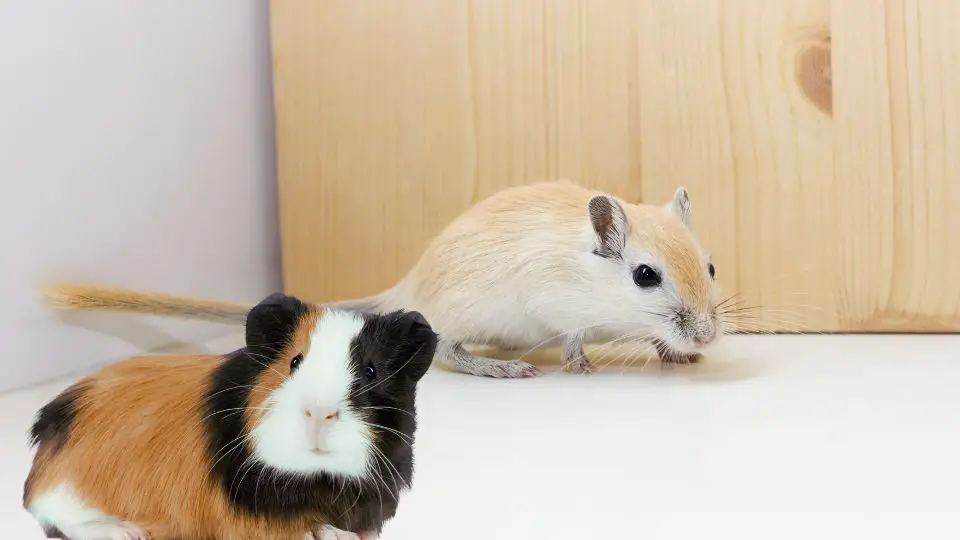Gerbils are relatively low-maintenance pets, but they still require some attention and handling. It’s important to get your gerbil used to you and your family so that it feels comfortable being handled. The best way to do this is by giving it treats while gently petting it.
Gerbils can also be trained to come when called! Start by calling your gerbil over and rewarding it with a treat. As your gerbil gets more comfortable, you can extend the training by calling it over to a different spot and giving a reward when it arrives.
In this article, we’ll look at how to bond with your gerbil and how you can train your gerbil to accept handling and even do some tricks.
Understanding Gerbil Behavior
Bonding and playing with our pets is one of the reasons we bring them into our lives, so before you keep a gerbil as a pet and start bonding with the small animal, it’s important to understand the little pets’ behavior.
Gerbils are social animals, and they are naturally inclined to live in groups and interact with other gerbils. This means that when it comes to handling and bonding with your gerbil, approach them in a way that is friendly and non-threatening.
One key difference between wild and domestic gerbils is that wild gerbils are naturally more skittish and may be more difficult to bond with. Domestic gerbils, on the other hand, have been domesticated for many years, and, as such, are typically more comfortable around humans.
When you’re trying to bond with your gerbil, pay attention to their body language. Gerbils will show signs of fear or discomfort through behaviors like freezing, running away, or puffing up their fur. On the other hand, a relaxed and comfortable gerbil will often be more active, curious, and may even come to you for pets or treats.
Signs of a relaxed gerbil include:
- Nose twitching
- Tail wagging
- Sitting still to be petted or held
- Climbing into your hands
Gerbils can make a variety of different sounds. These sounds can range from soft squeaks to loud chirps and can be used for different purposes such as communication, warning, or even just for fun. Let’s explore some of the most common gerbil noises and what they might mean.
Squeaks
Gerbils will often make soft squeaks when they are happy or content. This can be a sign that they are enjoying themselves or that they are comfortable with their surroundings.
Chirps
Gerbils can also make loud chirping noises when they are excited or playing. This is a common noise that you may hear when your gerbil is running on its wheel or exploring its cage.
Whistles
Some gerbils will make a whistle-like noise when they are feeling threatened or stressed. This can be a sign that they are feeling uncomfortable or that they need more space.
Growls
Gerbils can also make a low growling noise when they are feeling aggressive or territorial. This is usually a sign that they want to be left alone or that they are defending their territory.
Building Trust and Bonding with Your Gerbil
Once you have taken the time to understand your gerbil’s body language, it’s important to build trust. The best way to do this is by taking things slowly and allowing your gerbil to get used to your presence.
Start out by sitting quietly near your gerbil’s cage, so they can get used to seeing you. Once your gerbil becomes more comfortable with your presence, try offering them treats or toys through the bars of the cage. Doing this regularly will help your gerbil associate you with positive things, and they may even come to you when you call their name.
Another way to bond with your gerbil is by offering them regular gentle handling and petting. Gently scoop your gerbil up with both hands, and allow them to crawl around on your lap or on a flat surface. Be sure to speak softly and move slowly so that your gerbil doesn’t become startled or scared.
With regular handling (which we will explain next), your gerbil will eventually become more comfortable being held, and you may even be able to start taking them on short trips outside their cage.
Bonding takes time
In our experience, understanding your gerbil’s behavior is key to building a strong bond with them. You must protect your little pet, but also allow them to explore their natural environment. This can be done through regular handling and playtime, as well as providing a safe and stimulating environment for them to explore.
If your gerbil bites you, it is likely an indication that they are scared or uncomfortable. You should take steps to ensure your gerbil feels safe and secure, such as providing them with plenty of enrichments, giving them plenty of space, and reducing loud noises or sudden movements.
Remember, every gerbil is different, and some may take more time to bond than others. Don’t give up if your gerbil isn’t as friendly as you would like right away. With patience and time, your gerbil will eventually come around!
Preparing to Handle Your Gerbil
When it comes to handling your gerbil, make sure that they are comfortable and relaxed before you pick them up. This will help to ensure that the handling experience is positive for both you and your gerbil. Here are a few tips on how to approach your gerbil and prepare for handling:
- Talk to your gerbil in a calm and soothing voice. This will help to create a more relaxed environment and let your gerbil know that you’re there.
- Move slowly and calmly when approaching your gerbil. Rapid movements can startle them and cause them to become stressed.
- Gather your necessary supplies before you begin handling your gerbil. This can include a comfortable and safe carrier or pouch, as well as some treats to reward your gerbil for good behavior.

When handling your gerbil, remember that they are small and delicate animals. Be gentle and supportive when holding them.
Remember what we said about noises? Well, gerbils will often squeak and chirp and will show you when they are not prepared for handling. Be sure to pay attention to those noises and respect their boundaries!
Bonding with your little pet takes time, and if you force them to do something they don’t want to, it can take a long time for your gerbil to trust you again. So, be patient with your gerbil and take it slow!
Did you know?
Gerbils are highly active and need plenty of space to explore, play and exercise. Give your gerbil a big enough cage to accommodate their active lifestyle and keep them healthy and happy. Providing your gerbil with toys, tunnels, chew sticks, and other stimulating items will also help to keep them entertained and engaged.
Gerbils aren’t just active and playful, but they can also be surprisingly cuddly and affectionate. With enough love, patience, and understanding, you can share a happy and lasting bond with your gerbil!
Providing a Safe and Comfortable Hold
When holding your gerbil, be sure to keep them close to your body and provide a comfortable grip. Your hands should form a cup around your gerbil, supporting their body and preventing them from wriggling away. If you are using a pouch or carrier, make sure it is secure and that your gerbil can’t escape.
Here are some things you need to keep in mind when holding your small pet:
- Be sure to support your gerbil’s body with both hands when picking them up. This will prevent them from feeling scared or overwhelmed.
- Always make sure that your gerbil has a secure and comfortable grip on you. They should be able to move around, but not squirm out of your hands.
- Keep your gerbil in a safe environment without loud noises or sudden movement. This will help them feel secure and relaxed.
Taming your gerbil may take a bit of time and patience, but with regular handling and understanding of their behavior, you will soon have a loyal companion!
Even after the initial training, it is important to keep an eye on your gerbil and make sure that they don’t feel stressed or overwhelmed. Trust and loyalty are key, so be sure to take the time to get to know your gerbil and build a strong bond with them. You’ll be glad you did!
Step-by-step guide to tame and hold a gerbil
Here is the full step-by-step guide on taming and holding a gerbil:
- Talk to your gerbil in a gentle and calming voice before you pick them up.
- Move slowly and calmly when approaching your gerbil.
- Gather any necessary supplies before you handle your gerbil, such as a comfortable carrier or pouch, and treats.
- Pick up your gerbil with both hands, supporting their body and forming a safe grip.
- Keep your gerbil in a safe environment with minimal noise and activity.
- Offer treats, cuddles, and comfort to build trust and loyalty.
- Pay attention to your gerbil’s body language and squeaks—respect their boundaries!
- Keep an eye on your gerbil to make sure they don’t become overwhelmed or stressed.
- Provide plenty of toys, tunnels, and chew sticks for your gerbil to explore and play.
- With love, patience, and understanding, you can create a lasting bond with your little gerbil!
Unleashing the Potential: Training Your Gerbil
With regular handling and training, your gerbil can become a very loyal companion that can be trained to do a variety of tricks!
Tricks that gerbils can learn
Gerbils are intelligent and curious animals that can learn a variety of tricks. Some examples of tricks that gerbils can learn include:
- Coming when called: Gerbils can learn to associate their name with a treat or a favorite toy, and come to their owner when called.
- Following a target: Gerbils can learn to follow a target, such as a finger or a small object, which can be used to guide them around the cage or to a specific area.
- Jumping: Gerbils are naturally active and can be trained to jump over small obstacles, such as blocks or hurdles.
- Playing fetch: Gerbils can learn to pick up and retrieve small objects, like a ball or a piece of food, and bring it back to their owner.
- Tunneling: Gerbils can learn to navigate tunnels or mazes by following a treat or a target.
- Responding to commands: Gerbils can learn to respond to basic commands, such as “sit,” “stay,” or “come.”
- Clicker training: Gerbils can learn to associate a click with a reward and respond to it.
Training your gerbil
Now that you know what tricks your gerbil can learn, it’s time to start training! Training a gerbil is similar to training other small animals such as mice or rats. Here are some steps you can follow to train your gerbil:
- Use positive reinforcement: Whenever your gerbil performs a desired behavior, reward them with a treat or a special activity.
- Be consistent: Training takes patience and consistency. Use the same command every time you want your gerbil to perform a specific behavior.
- Keep training sessions short: Gerbils have a short attention span, so it’s best to keep training sessions to around 10-15 minutes.
- Start with simple commands: Begin by teaching your gerbil simple commands such as “come” or “stay.” Use a treat as a reward for correct behavior.
- Teach new tricks gradually: Once your gerbil has mastered a trick, slowly build on that by teaching them new and more difficult tricks.
- Provide mental stimulation: Gerbils are intelligent animals, so you should also provide them with mental stimulation, such as puzzles or toys that they can play with.
Common challenges
There are a few common challenges when training a gerbil. One challenge is that gerbils are naturally timid and cautious animals, which can make them hesitant to participate in training. This can be overcome by using positive reinforcement techniques, such as offering treats and praise for desired behaviors.
Gerbils also have a strong instinct to burrow and hide, which can make it difficult to train them to perform certain behaviors. To overcome this, it may be helpful to incorporate their natural instincts into the training, such as training them to retrieve items and hide them in a designated area.
Finally, gerbils can be very active, which can make it difficult to train them to remain still for extended periods of time. To overcome this, it may be helpful to incorporate physical activities, such as running and climbing, into the training sessions.
Conclusion
Wrapping all up, taming and holding your gerbil can be a rewarding experience for both you and your pet. With time, patience, understanding, and effort, you can build a strong bond with your gerbil that will last for years to come.
Be sure to provide them with plenty of space and stimulation to live an active and healthy lifestyle. Talk to your gerbil in a gentle voice before handling them, move slowly when approaching them, keep their environment safe and secure, and pay attention to their body language and squeaks.
You can offer treats or cuddles when necessary. These steps will help ensure that you have a happy relationship with your small furry friend! With the right amount of love and care, you’ll be able to enjoy all the joy and companionship that your gerbil has to offer.







